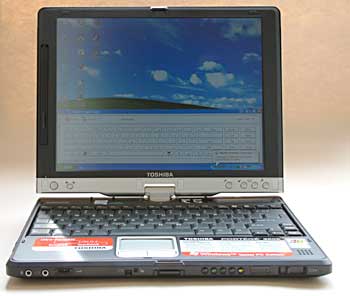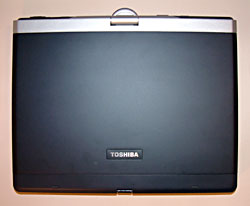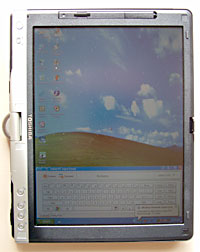|
|||||||||
Advertisement |
Home > Tablet Reviews > Toshiba Portege 3500
Toshiba Portege 3500
What's hot: Class-leading battery life, very good backlit keyboard. What's not: Dull design, dim display.
Reviewed November, 2002 by Lisa Gade, Editor in Chief (twitter: @lisagade)
If you want to read a brief intro to Windows XP Tablet Edition notebook features and specs, click here. The Toshiba Portege 3500 was one of the first Windows XP Tablet Edition notebooks to hit the shelves shortly after their Nov. 7th, 2002 launch by Microsoft. These tablet notebooks can double as a standard notebook and a digital notepad thanks to their convertible design. For more info on the standard features of Windows XP Tablet Edition, read our brief intro here.
Side view, showing left to right, the CF slot, PCMCIA slot, Ethernet jack (behind door), WiFi switch and SD card slot. Goodbye external card readers! First Impressions We got the 3505 model which is identical to the 3500 model except that it has 512 megs of RAM rather than 256 and is supposed to come with an external DVD drive. Out of the box, the Toshiba looks and feels sturdy, is not flashy looking, and is fairly small and light at 4.1 lbs. The case is a matte black finish that is durable, though it shows fingerprints (easy to clean). The pen fits flush into a slot on the light side of the display and feels good in the hand, having good mass and a comfortable shape. What's striking about the Portege 3505 is that it looks like an normal notebook computer. Only the telltale round swivel plate that connects the display to the body of the notebook gives it away. You'll get a standard notebook keyboard, a trackpad and the usual set of ports, making this a fully functional standard notebook. The box and sticker on the wrist rest area of the 3505 state that an external DVD drive is included (reads CDs, CDRs and DVDs). Well guess what boys and girls: you won't find one in the box! Instead you'll get a coupon that you can mail in to get a Targus Noteworthy DVD drive that connects to the Toshiba via a PCMCIA card. This isn't good news if you don't have an external CD drive handy-- without one, there's no way to install software, read the manuals (supplied as .pdf files on the CD) or to use the included recovery disks. If you need to boot from the recovery disks to set your 3505 back to the factory install state, you must use the drive from Toshiba, the machine will not boot from any other CD drive (though you can use other CD drives for non-boot tasks). The coupon is good until Jan. 15, 2003, and I hope at some point before then, the DVD drive will ship in the box. Battery Life, Screen, Sound, Software and Gaming The battery has lasted about 2.5 hours per charge so far with WiFi turned on. It charges rather quickly compared to other notebooks I've used (about 1.5 hours from empty to full charge). For a notebook of this size and speed, the battery life is average. Speaking of speed, the Toshiba is at the top of the pack with its 1.33GHz Mobile Pentium III. The poly silicon screen is capable of displaying 16 million colors at 1024 x 768 resolution. The surface seems durable and flexible and is designed to allow you to rest your hand on the screen without showing grease marks. You'll notice the surface feels a bit tacky, and that's because a resistive surface makes for a more natural (and not too slippery!) writing surface when using the stylus. |
|
How does the screen look compared to non-tablet PCs? It is not as bright or sharp, and the viewing angle is limited. That isn't to say the display isn't acceptable, it's perfectly usable, but don't expect it to be best of breed. Given that the screen is also a digitizing tablet, how much can we expect for $2,500 and less? I would like to see increased viewing angle: while we tend to use our notebooks in a single position as we work with them, a tablet PC can be held at any of several different angles when in tablet/portrait mode, and that means you're not always looking at the screen at its best viewing angle. Just as Microsoft promised, every commercial software package we've installed has worked fine. I installed and used Office 2000 Pro, Adobe Photoshop 7, Dreamweaver MX and several other apps without a problem. Using Photoshop and Fractal Painter is a dream on this machine, drawing and making lasso selections is a dream when you're using a pen directly on the screen rather than an accessory digitizer. I can't say enough about how wonderfully it works. You can even select the text tool in Photoshop, then use voice dictation to speak your text! What about games? Well, this isn't anyone's first choice as a gaming machine and that isn't its intended primary use. The video card, A CyberALADDiN-T with 16 megs max of shared memory isn't exactly a Radeon 9000, but for light game use it should do OK. The single speaker won't give you 3D sound effects, but it is quite loud and clear (you could plug in some speakers or headphones for a better audio experience). Of course, you'll need to use an external CD drive to play your game, since an optical drive isn't built into the notebook. I tried Need for Speed III (not the most recent of games, but the hardware demands in terms of video are tamer than today's games), and yes, it ran. No pen support to be found, which isn't surprising, and the graphics were fairly jaggy. The game automatically turned off some hardware acceleration features, so it ran without the bells and whistles that make it look better on more standard systems with dedicated video memory and faster video cards. The Pen and Voice Experience: Trying Out Those Tablet PC Features! Since handwriting recognition, digital ink technology, voice dictation and voice command are built into the operating system, don't expect much variation between competing brands and models. Machines with faster processors will translate handwriting into text more quickly, and will also do a better job of voice recognition. Most of the first generation machines will have similar processing power however. Also, a better built-in mic can help improve voice recognition, but you're really going to need a good quality headset mic if you want to successfully use voice dictation. Why? A good headset mic is always going to be of better quality compared to a built-in mic, and you won't have to worry as much about ambient noise. When you boot up your Portege 3505, you'll be greeted by an excellent tutorial that will walk you through using digital ink, handwriting recognition, voice commands and voice dictation. It really does tell you everything you need to know in a succinct manner. You'll even watch a few Windows Media Player movies in the process of learning about the Tablet PC features. And for us lefties out there, you'll be happy to know that you can tell it whether you're a southpaw or rightie. You can flip the screen in portrait mode so that the handgrip and button strip are on the left rather than the right. I am amazed at how well handwriting and voice recognition are integrated into both Microsoft and other companies' applications. I used voice and handwriting input to enter text into Dreamweaver, Photoshop and Office. Excellent! |
Top view of the Portege when closed. Note the sturdy swivel joint protrudes from the back.
The Portege 3505 in Tablet mode. |
|
Handwriting Recognition How well does it work? Pretty well, and I'm a lefty with poor handwriting. You can use handwriting recognition (HWR) with most any application. It's built into the OS, as is the on-demand on screen keyboard and voice command/ voice dictation app. You can write in either print or cursive, and specify the delay before your writing is translated. Windows Journal, included with Windows XP Tablet Edition, allows you to doodle, draw, write free-form and later select handwriting to be translated into text. It is a very useful and neat app! I can't imagine using this as a keyboard replacement, but for short emails and note taking while walking or standing it's great. Voice Recognition I'll be brutally honest: this feature makes for a great party game and not much better. Before you use speech, you must spend approximately 10 minutes doing an initial voice training exercise with the machine. After that, you can choose to read aloud excerpts from classic works (and Bill Gates' book) to put in more training time, which is supposed to improve accuracy. I did 3 training sessions, since the initial one yielded comic results. Things didn't get much better after the third training, but it did generate some really humorous sentences. My voice is female, fairly deep, and clear except for some hissing on "s" sounds and I do not have any accent. Surprisingly, it did not have trouble with my "s" sounds, but rather standard vowels. It does have a great deal of trouble discerning between similar sounds: i.e. "th" vs. "f" sounds, which are aurally though not linguistically similar. While similar sounds (such as deaf vs. death) can be confusing, other mistakes made by the machine made no sense at all. I tried speaking slowly and more clearly than I would in normal conversation-- no luck. I gave the tablet to another person (woman) and it had the same difficulties with her speech as mine (which leads me to believe that it doesn't really hone in on your voice, but rather your speech rate and voice pitch). 3 Different Card Slots and USB 2.0 Yep, you can throw your card reader away. The Portege 3500 series comes with a CompactFlash slot, SD (secure digital) slot and a PCMCIA type II slot. On top of that, you get two USB 2.0 ports supporting high data transfer rates with new USB 2.0 peripherals such as CD burners, scanners and etc.. Conclusion It's cool, way cool! It's also light, relatively small (though average in thickness) and is built to last. While it's heavier than some other Tablets, it is exceptionally durable. The processing power, hard drive and memory (for the 3505 which has 512 megs of RAM) are enough for serious work. In fact the Toshiba is the fastest of the first tablets to hit the market. The video card is not the greatest if you're a gamer or a heavy graphics person, but I imagine there are limitations as to which video cards can support the digitizer features. Should you buy one? If you intend to use the nifty special features of the Tablet OS, then yes. If you don't intend to use these features, then you can find a faster machine with a CD burner, firewire and a brighter sharper screen for the same money.
Suggested list price for 3500 (256 megs RAM, no DVD): $2299. Suggested list price for 3505 (512 megs RAM, DVD): $2499
Specs:
|




